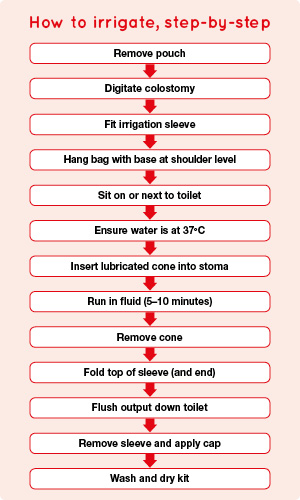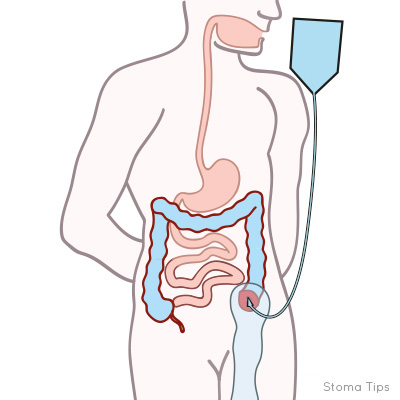For people with a colostomy, the main daily challenge can be how to manage its output. Typically, it is left to naturally collect throughout the day in a bag, which is then disposed of once full. The rate and consistency of this output can be managed with changes to diet and medicines. Colostomates who want to have complete continence and control without wearing a bag can instead use irrigation.
Irrigation allows colostomates to empty their colon by washing it out with water. This involves infusing body-temperature tap water into the colon via the colostomy. There it stimulates bowel contractions, pushing the contents out through the stoma and into an irrigation sleeve, which empties directly into the toilet. After irrigation, a stoma will typically go a whole 24 hours before it needs to function again.
 Who can do it
Who can do it
As irrigation requires stools to be formed (solid), it is only suitable for ostomates who have most of their large bowel intact. This means it is an option for most people with a left-sided end colostomy. Unfortunately, it is not safe or effective with an ileostomy or right-sided colostomy.
The ostomate needs to be able to see his or her stoma, as well as have the physical dexterity and mental capacity to pick up and perform the technique. There are also certain conditions, including ongoing colonic disease and stoma complications, that make irrigation unsafe to use. Before irrigating, it is also important to secure sole access to a bathroom.
Take care
Some conditions can make irrigation unsafe, so check with your nurse before starting irrigation if you have any of these:
• Disease in remaining colon (including Crohn’s disease, diverticular disease and radiation colitis)
• Parastomal hernia
• Prolapsed stoma
• Renal and/or cardiac disease, due to risk of fluid overload
• Stenosis
Hygiene and safety
For the sake of hygiene, it is important to wear disposable gloves while irrigating, as well as to thoroughly wash and dry irrigation equipment after use.
Irrigation shouldn’t be started until the all wounds from an operation are healed and any adjuvant treatment has been completed. Otherwise, there is little research about a best time to start, and irrigation can begin whenever the colostomate feels ready.
It is essential that first-time irrigators should never try to do it alone. It should instead be taught by a qualified stoma care nurse with experience of the technique, preferably in a hospital. Not only does this make sure everything is being done properly, the nurse can also check whether the body is reacting normally, as a minority of people experience a drop in blood pressure and pulse rate during irrigation.


Colostomy irrigation
Kit
Irrigating will require a specialised kit. There are two types of irrigation kits available: gravity kits and mechanical pumps. Both of these are available on prescription in the UK; however, mechanical pumps are much more expensive for the NHS and there is no evidence that they provide a better evacuation, so it is recommended to start with a gravity kit. A gravity kit will need to be suspended above the stoma, with the irrigation bag’s base at shoulder level, to allow gravity to assist with water flow. It can be helpful to place a shoulder-height hanging hook in the bathroom, with some pegs to keep the kit in place.
The kit comes with a soft cone that is lubricated and inserted into the stoma. As the direction your colon goes is not always obvious, it is helpful to feel inside with a gloved and lubricated finger (digitate).
You will also need a separate one-piece or two-piece irrigation sleeve to deposit the output into the toilet. Once irrigation is complete, the top of the sleeve should be folded over to allow other activities (if required, fold over end).
When irrigation is complete, the stoma needs to be covered with an appliance or stoma cap. When starting to irrigate, evacuation may be unpredictable, so it’s a good idea to keep wearing a normal pouch for a while. Once a routine has been established and no breakthrough is apparent, most ostomates prefer to wear a stoma cap. These are small pouches with a pad to soak up output and a filter for flatus, available in a variety of shapes and sizes.
You will need
• Disposable gloves
• Lubricant jelly
• Irrigation set (water container,
tubing and cone)
• Irrigation sleeve
• Hanging hook
• Pegs or clips
• Disposal bag
• Stoma pouch or cap
• Cleaning wipes
Fluid
The amount of water typically used in a single irrigation is 500ml. This is the recommended amount, but studies have shown using 250ml or 1000ml works just as well.1 If a breakthrough occurs, then the amount of water can be gradually increased. Tap water works perfectly well. This water should ideally be at room temperature, around 37oC, as cold water can cause cramps, and water that’s too hot can cause burns. Water should be run into the colon over 5–10 minutes, as any faster can also cause cramps.
Irrigation kit manufacturers
• Aquaflush (Acquaflush Actif)
• Dansac (Dansac Irrigation Kit)
• Hollister (Cone Irrigator Kit)
Timing
Ostomates are often concerned that irrigation will take a long time, but the evidence does not bear this out. A Turkish study found that ostomates did initially take 30–45 minutes to perform an irrigation while they were still learning the technique, but this time was soon reduced to 15 minutes with experience.2 Another study found no significant difference in how long it took to empty a colostomy whether using natural evacuation, a foam enema or irrigation.3 However, there is a learning curve, and it may take up to a month to get up to speed.
Irrigation should initially be performed every 24 hours, at a regular time to enable the bowel evacuation to establish a pattern. Most people are then able to go down to irrigating every other day with no increase in breakthrough.4 It may make sense to set this time around an hour after a regular meal, when the colon is most likely to be full.
Common issues |
|
|
Problem |
Solution |
|
Difficulty inserting cone |
Digitate stoma with gloved lubricated finger |
|
Difficulty infusing water |
Check angle of cone and reposition |
|
Abdominal cramping |
Check water temperature and slow insertion speed |
|
Failure of water to return |
Use larger volume of water, as fluid may have been absorbed |
|
Breakthrough evacuation |
Make sure to irrigate at regular time intervals |
Not to be confused with
Colostomy irrigation is similar but different to rectal irrigation and antegrade continent enema (ACE) washout, both of which are used by people with intact bowels to ease constipation or incontinence. In rectal irrigation, the bowel is flushed out from below, through the anal passage. In ACE, a passage is created using the appendix, through which a catheter is inserted to flush out the bowel from above.
Why irrigate
There are many common difficulties that can be eased with irrigation. A study found a quarter of colostomates gave bag disposal as the most difficult part of managing their stoma, while half of the people asked felt that their body was out of their control, and another third said they missed out on social activities because of their stoma.5
The challenges of constantly having to fit and change a stoma bag often lead to irritated skin. Meanwhile, many people find the wind (flatus) produced by a working stoma makes them uncomfortable in social situations and unable to participate in certain activities. Ostomates experiencing these issues might find irrigation increases their self-esteem and lets them live a normal life.
References
1 Meyhoff HH, Andersen B, Nielsen SL. Colostomy irrigation: a clinical and scintigraphic comparison between three different irrigation volumes. BJS. 1990; 77(10):1185–6
2 Karadag A, Mentes BB, Ayaz S. Colostomy irrigation: results of 25 cases with particular reference to quality of life. J Clin Nurs. 2005; 14(4):479–85
3 Doran J, Hardcastle JD. A controlled trial of colostomy management by natural evacuation, irrigation and foam enema. Br J Surg. 1990; 68(10):731–3
4 Gattuso JM, Kamm MA, Myers C et al. Effect of different infusion regimens on colonic motility and efficacy of colostomy irrigation. BJS. 1996; 83(10):1459–62
5 McKenzie F, White CA, Kendall S et al. Psychological impact of colostomy pouch change and disposal. Br J Nurs. 2006; 15(6):308–16
Colostomates who irrigate use around one and a half fewer appliances per day than those who do not. Therefore, people in countries where they have to purchase their own ostomy equipment can find irrigation also cuts down on costs.
If you have any issues with your colostomy, refer to the table above. If these problems persist, contact your stoma care nurse for support.
Yvette Perston is a clinical nurse specialist at Queen Elizabeth Hospital, Birmingham
The contents of this page are property of MA Healthcare and should not be reused without permission


